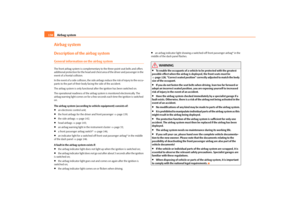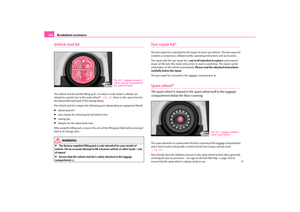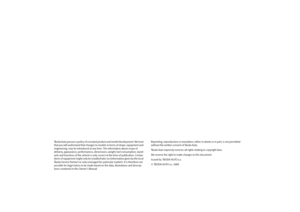Page 177 of 259

Taking care of your vehicle and cleaning the vehicle 176Plastic partsExternal plastic parts are cleaned by normal washing. Plastic parts and synthetic
leather can also be treated with special solvent-free plastic cleaning agents if a
damp cloth is not sufficient. Paint care products are not suitable for plastic parts.
Caution
Solvent-free cleaners attack the material and can damage it.WindowsOnly use a plastic ice scraper for removing snow and ice from the windows and
mirrors. You should not move the ice scraper forward and backward but in one
direction on the window which you are cleaning in order to avoid any damage to
the surface of the glass.
You can best remove residues of rubber, oil, grease, wax or silicone by using a
special window cleaner or a special silicone remover.
You should also clean the windows regularly from the inside.
Do not use window leathers which you have used to polish the vehicle body to dry
off the windows. Residues of preservatives in the window leather can dirty the
window and reduce visibility.
Do not affix any stickers over the inside of the rear window to avoid damage to the
heating elements of the rear window heater.
We recommend using a preservative from Škoda genuine accessories offered by
your Škoda dealer.
Caution
•
Never remove snow or ice from the glass parts with warm or hot water - risk of
formation of cracks in the glass!
•
When removing snow or ice from the windows and mirror lenses make sure not
to damage the paintwork of the vehicle.
The headlight lensesPlease do not use any aggressive cleaning or chemical solvent products for cleaning
the front headlights - risk of damage to the plastic lenses. Please use soap and
clean warm water.
Caution
Never wipe the headlights dry and do not use any sharp objects for cleaning the
plastic lenses, this may result in damage to the protective paintwork and conse-
quently in formation of cracks on the headlight lenses, e.g through effect of chem-
ical products.Door and window sealsThe rubber seals on the doors, boot lid, bonnet and windows remain supple and
last longer if you treat them from time to time with a rubber care product (e.g. with
a spray with silicone-free oil). You also avoid premature wear of the seals and
prevent leakages in this way. It is also easier to open the doors. Rubber seals which
are well cared for also do not stick together in cold winter weather.Locking cylinderWe recommend that you use the spray from Škoda original accessories with
regreasing and anticorrosive effect for de-icing locking cylinders.
Note
When washing your vehicle, ensure that as little water as possible gets into the
locking cylinders.
s3f4.1.book Page 176 Thursday, June 18, 2009 11:07 AM
Page 178 of 259

Taking care of your vehicle and cleaning the vehicle177
Using the system
Safety
Driving Tips
General Maintenance
Breakdown assistance
Technical Data
WheelsSteel wheels
You should also thoroughly wash the wheels and wheel trims when giving your
vehicle its regular wash. This prevents any brake dust, dirt and road salt from
sticking to the wheel hubs. You can remove stubborn brake abrasion adhering to
t h e w h e e l s w i t h a n i n d u s tr i a l c l e a n e r. To u c h u p a n y d a m a g e to t h e p a i n tw o r k o n th e
wheels before rust is able to form.
Light alloy wheels
Regular care of light alloy wheels is necessary in order to retain their decorative
appearance over long periods. It is particularly important to remove any road salt
and brake abrasion from light alloy wheels every two weeks, otherwise the surface
will suffer. Wash thoroughly and then treat the wheels with a protective product for
light alloy wheels which does not contain any acidic components. You should
provide the wheel hubs with a hard wax layer every three months. You must not use
any products which cause abrasion when treating the wheel hubs. Any damage to
the paint layer on the wheel hubs must be touched up immediately.
We recommend using a preservative from Škoda genuine accessories offered by
your Škoda dealer.
WARNING
One should remember when cleaning the wheels that moisture, ice and road
salt may adversely affect braking efficiency - risk of an accident!
Note
Severe layers of dirt on the wheels can also result in wheel imbalance. This may
show itself in the form of a wheel vibration which is transmitted to the steering
wheel which, in certain circumstances, can cause premature wear of the steering.
This means it is necessary to remove the dirt.
Underbody protectionThe underside of your vehicle is protected for life against chemical and mechanical
influences.
One cannot, however, completely rule out damage to the protective layer when
driving so we recommend that you inspect the protective layer on the underside of
your vehicle and on the chassis at certain intervals - this is best done at the begin-
ning and end of the winter - and to touch up any damaged areas.
Specialist garages have suitable spray products available as well as the necessary
equipment and are familiar with the instructions for use. Therefore, we recommend
you have such touch-up work or additional corrosion protection measures carried
out by a specialist garage.
WARNING
Never use additional underbody protection or corrosion-protection agents
for the exhaust pipes, catalytic converters or heat shields. These products
might ignite when driving - risk of fire!Protection of hollow spacesAll the cavities of your vehicle which are at risk from corrosion are protected for life
by a layer of protective wax applied in the factory.
This wax protection does not require to be inspected or re-treated. Please remove
any small amount of wax which flows out of the cavities at high temperatures with
a plastic scraper and clean the spot using petroleum cleaner.
WARNING
Safety and environmental protection regulations should observed when
using petroleum cleaner to remove wax - a risk of fire!
s3f4.1.book Page 177 Thursday, June 18, 2009 11:07 AM
Page 179 of 259

Taking care of your vehicle and cleaning the vehicle 178Engine compartmentGood corrosion protection is very important, particularly in winter when one often
drives over its salt-strewn roads. One should therefore clean the entire engine
compartment before and after the salt spreading period, in order to prevent the salt
from being destructive.
Specialist garages have the cleaning agents recommended by the manufacturer
and also the required equipment.
WARNING
•
It is necessary to observe the guidelines given in the chapter before
working on the engine compartment ⇒page 185.
•
Let the engine cool down before cleaning the engine compartment.Caution
•
Engine cleaning may be only be undertaken when the ignition is off.
•
It is recommended to cover the generator before washing the engine compart-
ment.For the sake of the environment
The dirty water produced by washing the engine has washed away petrol, and resi-
dues of grease and oil and should therefore be cleaned by an oil separator. This is
why engine washing should only be undertaken in garages or at filling stations
(when these are fitted with the required equipment).Care of the interior of vehiclePlastic parts, artificial leather and clothsYou can clean plastic parts and artificial leather with a moist cloth. You should only
treat such parts with special solvent-free plastic cleaning and care products it
does prove to be adequate.Upholstery cloth and cloth trim on the doors, luggage compartment cover, head-
liner etc. are best treated with special cleaning products, using if necessary a dry
foam and a soft sponge or brush.
We recommend using a cleaning product from Škoda genuine accessories offered
by your Škoda dealer.
Caution
Solvent-free cleaners attack the material and can damage it.Fabric covers of electrically heated seatsDo not clean the seat covers moist as this may result in damage to the seat heating
system.
Clean such covers using special agents, for example dry foam.
We recommend using a cleaning product from Škoda genuine accessories offered
by your Škoda dealer.Natural leather
Natural leather requires quite particular care and attention.Leather should be treated from time to time according the following
guidelines depending on how much it is used.
Normal cleaning
– Clean soiled areas of the leather with slightly moistened cotton or
woollen cloth.
Severe soiling
– Clean severely soiled areas with a cloth dipped in a mild soapy solu-
tion (2 spoonfuls of natural soap to 1 litre of water).
s3f4.1.book Page 178 Thursday, June 18, 2009 11:07 AM
Page 180 of 259

Taking care of your vehicle and cleaning the vehicle179
Using the system
Safety
Driving Tips
General Maintenance
Breakdown assistance
Technical Data
– Ensure that the leather is not soaked through at any point and that no
water gets into the stitching of the seams.
– Dry off the leather with a soft, dry cloth.
Removing stains
– Remove fresh stains which are water-based (e.g. coffee, tea, juices,
blood etc.) with an absorbent cloth or household paper or use the
cleaner from the care set for a stain which has already dried in.
– Remove fresh stains on a fat base (e.g. butter, mayonnaise, chocolate
etc.) with an absorbent cloth or household cleaning paper or with the
cleaner from the care set if the stain has not yet penetrated into the
surface.
– Use a grease dissolver for grease stains which have dried in.
–Eliminate special stains (e.g. ball-point pens, felt pen, nail varnish,
dispersion paint, shoe cream etc.) with a special stain remover suit-
able for leather.
Leather care
– Treat the leather every six months with the leather care product avail-
able from specialist garages.
– Apply only a small amount of the care product.
– Dry the leather off with a soft clothWe recommend that you consult your Škoda Service Partner, if you have any ques-
tions regarding cleaning and care of the leather interior.
We recommend using a cleaning product from Škoda genuine accessories offered
by your Škoda dealer.
Caution
•
You must on no account treat the leather with solvents (e.g. gasoline, turpen-
tine), floor wax, shoe cream or such like.
•
Avoid leaving your vehicle for lengthy periods in bright sunlight in order to
avoid bleaching the leather. If you leave your vehicle parked in the open for lengthy
periods, protect the leather from the direct rays of the sun by covering it over.
•
Sharp-edged objects on items of clothing such as zip fasteners, rivets, sharp-
edged belts may leave permanent scratches or signs of rubbing on the surface.Note
•
Use a care cream with light blocker and impregnation effect regularly and each
time after cleaning the leather. The cream nourishes the leather, allows it to breathe
and keeps it supple and also provides moisture. It also creates surface protection.
•
Clean the leather every 2 to 3 months, remove fresh soiling each time this
occurs.
•
Remove fresh stains such as those from ball-point pens, ink, lipstick, shoe
cream etc., as quickly as possible.
•
Care also for the leather dye. Refreshen areas which have lost their colour with
a special coloured leather cream as required.
•
The leather is a natural material with specific properties. During the use of the
vehicle, minor optical changes can occur on the leather parts of the covers (e. g
wrinkles or creases as a result of the stress of the covers).
Seat belts– Keep the seat belts clean!
– Wash seat belts which have become soiled using a mild soapy solu-
tion.
– Inspect the seat belts regularly to ensure they are in good condition.Belt webbing which has become severely soiled may prevent the inertia reel from
reeling up the belt properly.
s3f4.1.book Page 179 Thursday, June 18, 2009 11:07 AM
Page 181 of 259
Taking care of your vehicle and cleaning the vehicle 180
WARNING
•
The seat belts must not be removed for cleaning.
•
Never clean the seat belts chemically as dry cleaning may destroy the
fabric. The seat belts must also not be allowed to come into contact with
corrosive liquids (such as acids etc.).
•
Seat belts which have damage to the webbing, the connections, the
inertia reel or the lock should be replaced by a specialist garage.
•
Inertia reel belts must be completely dried before being reeled up.
s3f4.1.book Page 180 Thursday, June 18, 2009 11:07 AM
Page 182 of 259

Fuel181
Using the system
Safety
Driving Tips
General Maintenance
Breakdown assistance
Technical Data
FuelPetrolGrades of petrolThere are various grades of petrol. Please read the chapter Technical Data in order
to know which grade of petrol your vehicle requires. You will also find the same
information affixed to the inside of the fuel filler flap of your vehicle ⇒page 182,
fig. 178.
A distinction is made between unleaded and leaded petrol. All Škoda vehicles with
petrol engines are equipped with a catalytic converter and must therefore be only
driven with unleaded petrol. Unleaded petrol must comply with the standard
EN 228.
The individual grades of petrol are distinguished by their octane number (RON).
Please adopt the following procedure if the grade of petrol which you normally use
is not be available in exceptional circumstances:•
Engines which need unleaded premium petrol 95 RON can also be run on
unleaded regular petrol 91 RON. This does, however, result in a slight loss in
performance.
If, in an emergency, the only fuel available is one which has a lower octane number
than that required by the engine then only drive at medium engine speeds and
lower engine loadings.
You can make unlimited use of fuel which has a higher octane number than that
required by the engine. There will, however, be no advantages gained by this in
terms of engine performance and fuel consumption!
The handling, performance and life of your engine are determined to a significant
extent by the quality of the fuel. Do not use any petrol additives. Use fuel which
complies with the standard EN 228.
You can find further information on refuelling ⇒page 182.
Caution
•
Filling the tank even only once with leaded petrol will result in the catalytic
converter being destroyed.
•
Operating the engine with petrol of a lower octane number than that prescribed
can result in engine damage at high revolutions or severe engine loading.
DieselDiesel fuelYour vehicle can be operated with diesel fuel, which complies with the standard
EN 590.
Fuel additives
You must not use fuel additives, so-called “flow improvers” (petrol and similar
products) in diesel fuel.
If the quality of the diesel fuel is poor, it is then necessary to drain the fuel filter
more often than stated in the Service schedule.
You can find information on refuelling ⇒page 182, “Refuelling”.
Caution
•
Use fuel which complies with the standard EN 590. Filling the tank even only
once, which does not comply with the standard, can result in damage to the fuel
system.
•
Water which has collected in the fuel filter can result in engine problems.
•
Your vehicle is not adapted for use of biofuel (RME), therefore this fuel must not
be refuelled and driven. Using this fuel (RME) can lead to damage to the engine or
the fuel system.
s3f4.1.book Page 181 Thursday, June 18, 2009 11:07 AM
Page 183 of 259

Fuel 182Operation in winterWinter-grade diesel fuel
A different grade of diesel fuel is available at filling stations in winter than during the
summer. Using “summer-grade diesel fuel” at temperatures below 0°C can result in
operational problems because the diesel becomes viscous as a result of paraffin
separation.
It is therefore the case that EN 590 prescribes diesel fuel class for certain periods of
the year which can also be purchased at the corresponding time during the year.
“Winter-grade diesel fuel” will still operate properly even at a temperature of -20°C.
It is often the case in countries with different climatic conditions that diesel fuels
available have a different temperature characteristic. The specialist garages and the
filling stations in the country concerned will be able to provide you with informa-
tion regarding the diesel fuels available.
Prewarming fuel
The vehicle is fitted with a fuel filter prewarming system. This secures operation of
a vehicle using diesel fuel down to an environmental temperature of -25°C.
Caution
It is not permitted to add the various fuel additives on the market, including petrol,
to diesel fuel in order to improve its flow properties.
RefuellingOpen fuel filler flap
– Open the fuel filler flap with the hand ⇒fig. 177.
– Unlock the fuel filler cap on the fuel filler tube to the left using the
vehicle key.
– Unscrew the fuel filler cap anti-clockwise and place the fuel filler cap
from above on the fuel filler flap ⇒fig. 178.
Closing fuel filler cap
– Screw on the cap by turning it to the right until it is heard to lock.
Fig. 177 Right rear side of
the vehicle: Fuel filler flapFig. 178 Fuel filler flap with
cap unscrewed
s3f4.1.book Page 182 Thursday, June 18, 2009 11:07 AM
Page 184 of 259

Fuel183
Using the system
Safety
Driving Tips
General Maintenance
Breakdown assistance
Technical Data
– Lock the fuel filler cap on the fuel filler tube by turning the vehicle key
to the right and withdraw the key.
– Press the fuel tank flap closed.The correct grades of fuel for your vehicle are stated on a sticker affixed to the inside
of the fuel filler flap. Further information on fuel ⇒page 181.
The fuel tank has a capacity of about 45 litres.
WARNING
Pay attention to any legal requirements if you do carry a spare canister in the
vehicle. We do not recommend carrying any fuel canisters in your vehicle for
safety reasons. The canister can be damaged in the event of an accident and
fuel may leak out.
Caution
•
Remove any fuel which has spilled onto the paintwork of your vehicle immedi-
ately - risk of paint damage!
•
On vehicles fitted with a catalytic converter, never let the fuel tank run
completely empty. An irregular supply of fuel to the engine can result in misfiring
and unburnt fuel may get into the exhaust system, which may result in overheating
and damage to the catalytic converter.
•
Make sure that the valve is not pressed into the filler tube when inserting the
pump nozzle into the filler tube. Otherwise you are unintentionally filling up the
volume, which in case of heat can cause an expansion of the fuel. This can lead to
an overflow of fuel or damage to parts of the fuel reservoir.
•
T h e f u e l t a n k i s f u l l j u s t a s s o o n a s t he pump nozzle switches off for the first time,
provided the nozzle has been operated properly. Do not continue refuelling -
otherwise the expansion volume is filled up.
s3f4.1.book Page 183 Thursday, June 18, 2009 11:07 AM
 1
1 2
2 3
3 4
4 5
5 6
6 7
7 8
8 9
9 10
10 11
11 12
12 13
13 14
14 15
15 16
16 17
17 18
18 19
19 20
20 21
21 22
22 23
23 24
24 25
25 26
26 27
27 28
28 29
29 30
30 31
31 32
32 33
33 34
34 35
35 36
36 37
37 38
38 39
39 40
40 41
41 42
42 43
43 44
44 45
45 46
46 47
47 48
48 49
49 50
50 51
51 52
52 53
53 54
54 55
55 56
56 57
57 58
58 59
59 60
60 61
61 62
62 63
63 64
64 65
65 66
66 67
67 68
68 69
69 70
70 71
71 72
72 73
73 74
74 75
75 76
76 77
77 78
78 79
79 80
80 81
81 82
82 83
83 84
84 85
85 86
86 87
87 88
88 89
89 90
90 91
91 92
92 93
93 94
94 95
95 96
96 97
97 98
98 99
99 100
100 101
101 102
102 103
103 104
104 105
105 106
106 107
107 108
108 109
109 110
110 111
111 112
112 113
113 114
114 115
115 116
116 117
117 118
118 119
119 120
120 121
121 122
122 123
123 124
124 125
125 126
126 127
127 128
128 129
129 130
130 131
131 132
132 133
133 134
134 135
135 136
136 137
137 138
138 139
139 140
140 141
141 142
142 143
143 144
144 145
145 146
146 147
147 148
148 149
149 150
150 151
151 152
152 153
153 154
154 155
155 156
156 157
157 158
158 159
159 160
160 161
161 162
162 163
163 164
164 165
165 166
166 167
167 168
168 169
169 170
170 171
171 172
172 173
173 174
174 175
175 176
176 177
177 178
178 179
179 180
180 181
181 182
182 183
183 184
184 185
185 186
186 187
187 188
188 189
189 190
190 191
191 192
192 193
193 194
194 195
195 196
196 197
197 198
198 199
199 200
200 201
201 202
202 203
203 204
204 205
205 206
206 207
207 208
208 209
209 210
210 211
211 212
212 213
213 214
214 215
215 216
216 217
217 218
218 219
219 220
220 221
221 222
222 223
223 224
224 225
225 226
226 227
227 228
228 229
229 230
230 231
231 232
232 233
233 234
234 235
235 236
236 237
237 238
238 239
239 240
240 241
241 242
242 243
243 244
244 245
245 246
246 247
247 248
248 249
249 250
250 251
251 252
252 253
253 254
254 255
255 256
256 257
257 258
258






